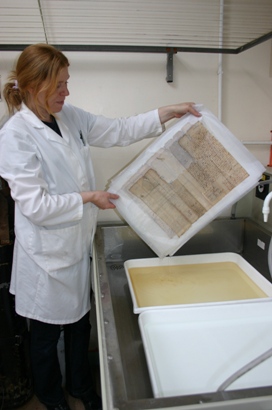Conservation of cultural heritage
The definition of the role of the conservator involves the examination, conservation, and preservation of cultural heritage using some simple ethical guidelines, such as:
- Minimal intervention;
- Appropriate materials and methods that aim to be reversible to reduce possible problems with future treatment, investigation, and use, and are as compatible as possible to the original material being worked on;
- Testing prior to treatment to determine that the method of treatment is safe;
- Full documentation of all work undertaken.
There are two kinds of conservation.
Preventive Conservation
Paper and books are sensitive to environmental conditions such as temperature, humidity and exposure to light and ultraviolet light. They should be protected in a controlled environment where such variables are maintained within a range of damage-limiting levels. Preventive conservation is an important element of collections care. It is important to create and maintain a protective environment for the collections, whether in store, on display, or in transit. A museum/library has to carefully monitor the condition of collections to determine when an item requires conservation work and the services of a qualified conservator.
Interventive Conservation
Interventive conservation refers to any act by a conservator that involves a direct interaction between the conservator and the cultural material. These interventive treatments could involve cleaning, stabilizing, or repair of the original object. Complete documentation of the work is carried out before, during, and after the treatment.
Conservation of wills and other probate records
Some of the Probate documents are so fragile they cannot be handled without causing further damage. Their condition is a result of rough handling, poor storage and environmental conditions before they were stored in an environmentally controlled strong room, or through the chemical reactions of the iron gall ink which is naturally acidic, on the paper. Conservation treatment suspends and slows down the process of degradation of the paper to ensure its survival for the future.
Since the start of the project 72 Probate bonds and 645 wills (755 items) have been conserved. To conserve one single manuscript takes approximately 4.5 hours depending on the grade of damage. Some very badly damaged manuscripts and parchment documents can take several days to finish. This display will take you through the different stages of conservation and show you some of the tools and materials which are used.
Mechanical cleaning
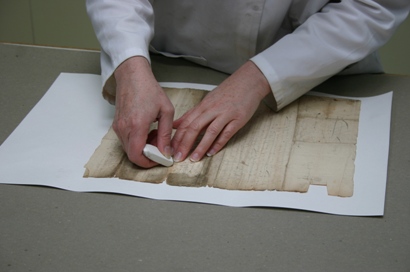
The first step in conserving this 1597 will is to clean the surface to remove the dust and dirt that has collected over the years. We use a plastic eraser that has been proven to leave no residue on the surface of the paper. The eraser is used either whole for less fragile documents or grated for fragile documents. The grated granules are rubbed gently on the surface of the paper with a finger to avoid harming the manuscript.
Wet Treatment
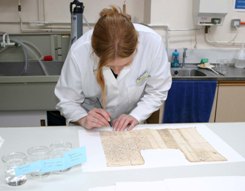
Paper can become acidic and damaged from iron gall ink, mould growth and poor storage conditions, making it necessary to treat the paper to ensure its survival. The inks on the document are spot tested to make sure they remain stable in water, and the paper can then be washed to remove soluble acidity and dirt.
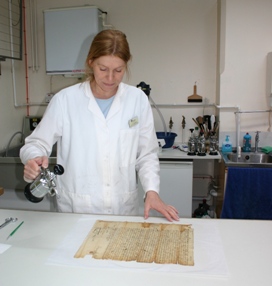
This also has the benefit of strengthening some damaged areas of the paper by rehydrating the paper fibres. A tray is filled with deionized water and the pH of the water is raised to pH7 with the addition of an alkaline calcium hydroxide solution. The document is stabilised on a support fabric and sprayed with a mixture of deionized water and IDA (alcohol) to enable the water to fully penetrate the paper.
The next stage is de-acidification of the manuscript in magnesium bicarbonate. This completes the removal of soluble acidity from the paper and leaves an alkali "buffer" in the paper which helps to protect it against further damage from acidity.
Resizing
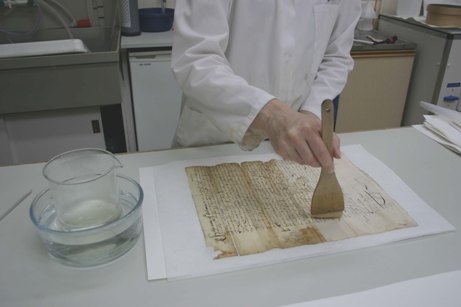
Sometimes the paper requires resizing after washing to give it more strength and to protect the surface of the document. We use gelatine size - which is how the paper was originally sized. This is made by dissolving gelatine in warm water in a 1 or 2 % solution depending on how much resizing the paper requires.
Paper Repair
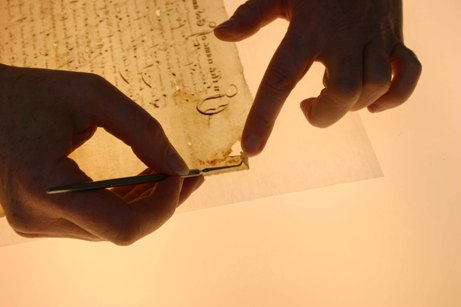
Paper is repaired either wet or dry using different weights of Japanese paper according to the weight of the original document, to repair tears and fill in missing areas. The tears or weak areas are lined with a very transparent low weight of Japanese paper so the text isn't obscured. Wheat starch paste is used as an adhesive.
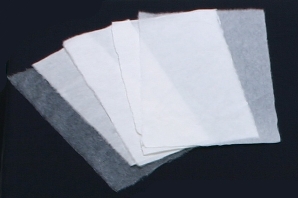
Different weights of these handmade Japanese papers are used to repair tears or fill in missing areas of loss. Japanese Paper is chosen for its very long and very strong fibres which make the repair very durable and long lasting. Unfortunately the art of making paper is a dying one and it gets more and more difficult to buy these papers.
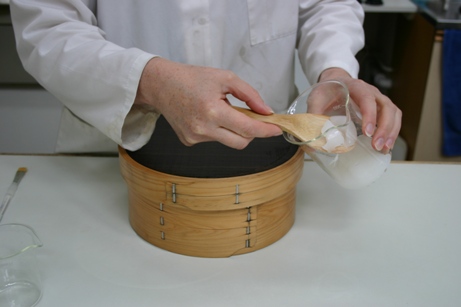
Wheat starch paste is an adhesive made by mixing and cooking an extremely pure form of wheat starch in water. It is used in paper repair by conservators because it makes relatively strong bonds but is easily removed with moisture or humidity, and does not discolour or deteriorate over time.

The document is laid out on a light table supported by a special support fabric. If it is to be a wet repair (for documents with very large areas needing repair) the document is then sprayed with water to flatten it. A sheet of melinex (clear polyester) is laid over the area of loss on the document. A piece of Japanese paper is laid on top of the melinex and the shape of the missing area of the document is traced onto the Japanese paper using a water pen, and then torn out. This is pasted out and laid on the missing area with the long fibres of the torn edge of the repair paper overlapping the document by only a millimetre. This is then repeated on the other side of the document. The document is then left to dry under weights or in a press. These paper repairs are very durable and also completely reversible. The document can be handled without further damage occurring once it has been repaired.
Parchment Repair
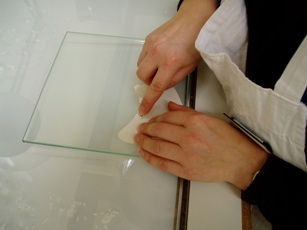
Parchment is a material made from the polished skin of a calf, sheep, goat or other animal, used like paper for writing on. Here it is used to repair parchment documents; specifically to fill in missing areas. Some documents were written on parchment which has completely different attributes to paper. Like paper it gets damaged through handling, iron gall ink or poor storage. To fill in areas of loss we use a similar weight of parchment to the document itself. The missing area is traced onto the repair parchment, with a small overlap onto the original document. This overlap is pared very thin with a scalpel.
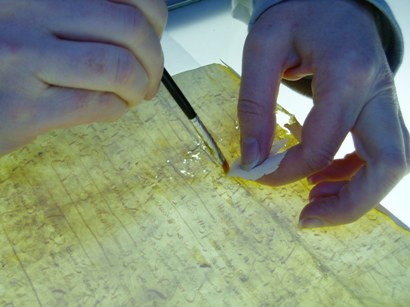
A solution of gelatine in hot water is used as the adhesive and applied to the pared edge. The conservator has to work quickly before the gelatine glue dries.
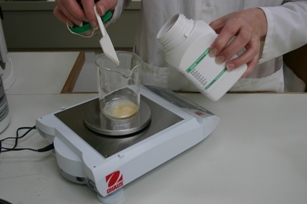
Gelatine adhesive is used as the adhesive for parchment repair. Gelatine is used because it has similar attributes to animal skin and therefore reacts the same way as the parchment to changes in temperature and humidity. This prevents the repair causing stress and strain to the document which could result from a non compatible repair. The adhesive is prepared by heating gelatine granules in a solution of hot water.
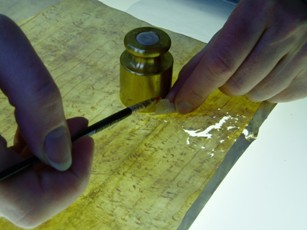
Goldbeater's skin is produced out of the outer membrane of calf's intestine - it is a material traditionally used in the process of reducing gold into mere 1µm thick leaves. Up to 120 sheets of gold laminated with goldbeater's skin can be beaten at the same time, since the skin is thin, elastic and does not tear under heavy goldbeating. Here it is used to repair tears in parchment manuscripts.



